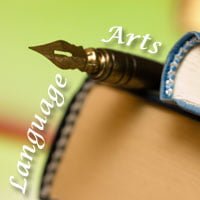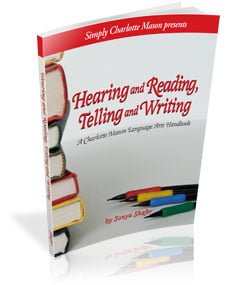60-day returns • free shipping on USA orders $129+


In my years of helping other Charlotte Mason homeschoolers, probably the one topic that comes up most often is language arts. I receive questions from “How do you do language arts the Charlotte Mason way?” to “What about composition?” to “How do you teach spelling and vocabulary?” to “Can you recommend a living English grammar book?”
So let’s take some time to look together at language arts. Over the next several weeks we will discuss what is included in language arts and how Charlotte taught all those components in simple yet effective ways. Today, let’s start by defining what “language arts” means.
What Is Language Arts, Anyway?
Don’t let the fancy term throw you: “language arts.” Back in Charlotte Mason’s day that term didn’t exist. It’s simply an educational label that was invented along the way. In fact, let’s take the term apart for a moment and think about what it means.
“Art” is a way of communicating an idea, whether it is done through music, paint, sculpture, or dance. The goal of “art” is to communicate an idea.
Now add the word “language” to that concept. The goal of “language arts” is to be able to use a language proficiently in order to communicate an idea.
That’s it. Nothing scary or intimidating. Just learning how to communicate ideas through language. You’ve been teaching language arts to your children naturally since they were born.
The Parts of Language Arts
Since we want our children to be proficient at communicating ideas through language, we want to make sure we cover all the ways language occurs. So language arts include the four main components of
- Listening,
- Reading,
- Speaking, and
- Writing.
Everything that relates to listening, speaking, reading, and writing in your selected language can be considered part of your language arts program.
Teachers through the years have tried to break down that big goal of “communicating ideas through language” into individual skills to work on (as teachers are apt to do). Most language arts programs will include these specific skills.
- Alphabet
- Listening Skills
- Phonics/Beginning Reading
- Parts of Speech
- Rhyming Words
- Sentence Structure
- Handwriting
- Punctuation
- Reading Comprehension
- Capitalization
- Writing Composition
- Public Speaking
- Vocabulary
- Proofreading
- Spelling
- Grammar
- Reference skills (alphabetizing; using a dictionary, etc.)
- Word study (homonyms, synonyms, prefixes, suffixes)
Most traditional language arts programs cover those skills as fifteen or more separate subjects. Charlotte Mason used about half that many subjects and still covered all the skills in an interesting and living way that kept the students’ attention and encouraged them to love learning.
How? We’ll look at the specifics in the coming weeks.
New Language Arts Handbook


We’re excited to announce the newest addition to our Charlotte Mason handbook series: Hearing and Reading, Telling and Writing. Everything that we will cover in this series of posts is included in this new handbook, plus lots more helpful information and encouragement.
In its pages you will find that Charlotte’s approach to language arts is simple, saves time, and uses common sense methods.
It is my hope that having Charlotte’s methods and ideas gathered into one place, along with her own words, will provide you with a quick go-to resource that will boost your confidence and reassure you that you have “this language arts thing” covered.
Be sure to download the free sample of this new book. It includes the simple what-to-teach-when chart, as well as the entire chapter on narration.
